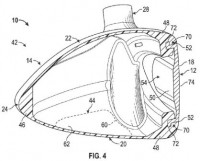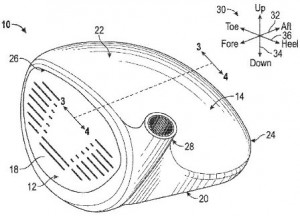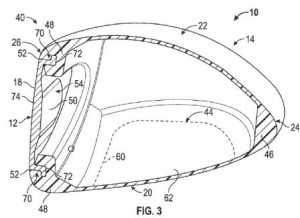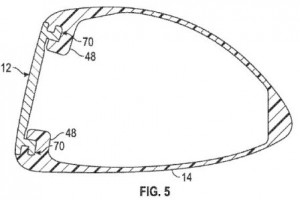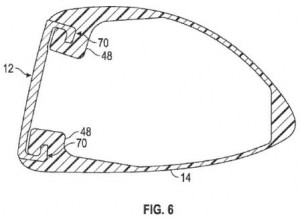Will We See a Plastic Driver from Nike Golf?
Please… of course not, but that doesn’t mean they aren’t working on one, as evidenced by a recently published patent application. If they do launch one within the next 5 years I will applaud their gumption and actually purchase it (a pretty safe bet in my eyes).
The patent application published as US Pub. No. 20150038259 titled “Lost-Core Molded Polymeric Golf Club Head,” which describes the invention as:
A method of forming a golf club head includes forming a core of the golf club head from a material having a first melting temperature and affixing a club face to the core. The club face includes a first, hitting surface, a second surface that is opposite the first surface, and a locking feature. A body is then molded about the core and such that it surrounds at least a portion of the locking feature, the body formed from a polymeric material having a second melting temperature that is greater than the first melting temperature. Finally, the core is removed from within the body.
The application explains:
BACKGROUND
[0003] A golf club may generally include a club head disposed on the end of an elongate shaft. During play, the club head may be swung into contact with a stationary ball located on the ground in an effort to project the ball in an intended direction and with a desired vertical trajectory. This impact may generate momentary impact forces on the club face that can peak in the range of about 6520 N to about 18000 N (about 1520 lbf to about 4000 lbf).
[0004] Many design parameters must be considered when forming a golf club head. For example, the design must provide enough structural resilience to withstand repeated impact forces between the club and the ball, as well as between the club and the ground. The club head must conform to maximum size requirements set by different rule setting associations, and the face of the club must not have a coefficient of restitution above a predefined maximum (measured according to applicable standards). Assuming that certain predefined design constraints are satisfied, a club head design is typically quantified by the magnitude and location of the center of gravity, as well as the head’s moment of inertia about the center of gravity and/or the shaft.
[0005] The club’s moment of inertia relates to the club’s resistance to rotation (particularly during an off-center hit), and is often perceived as the club’s measure of “forgiveness.” In typical driver designs, high moments of inertia are desired to reduce the club’s tendency to push or fade a ball. Achieving a high moment of inertia generally involves placing mass as close to the perimeter of the club as possible (to maximize the moment of inertia about the center of gravity), and as close to the toe as possible (to maximize the moment of inertia about the shaft).
[0006] While the moment of inertia affects the forgiveness of a club head, the location of the center of gravity behind the club face (and above the sole) generally affects the trajectory of a shot for a given face loft angle. A center of gravity that is positioned as far rearward (away from the face) and as low (close to the sole) as possible typically results in a ball flight that has a higher trajectory than a club head with a center of gravity placed more forward and/or higher.
[0007] While a high moment of inertia is obtained by increasing the perimeter weighting of the club head, an increase in the total mass/swing weight of the club head (i.e., the magnitude of the center of gravity) has a strong, negative effect on club head speed and hitting distance. Said another way, to maximize club head speed (and hitting distance), a lower total mass is desired; however a lower total mass generally reduces the club head’s moment of inertia (and forgiveness).
[0008] In the tension between swing speed (mass) and forgiveness (moment of inertia), it may be desirable to place varying amounts of mass in specific locations throughout the club head to tailor a club’s performance to a particular golfer or ability level. In this manner, the total club head mass may generally be categorized into two categories: structural mass and discretionary mass.
[0009] Structural mass generally refers to the mass of the materials that are required to provide the club head with the structural resilience needed to withstand repeated impacts. Structural mass is highly design-dependant, and provides a designer with a relatively low amount of control over specific mass distribution. On the other hand, discretionary mass is any additional mass that may be added to the club head design for the sole purpose of customizing the performance and/or forgiveness of the club. In an ideal club design, the amount of structural mass would be minimized (without sacrificing resiliency) to provide a designer with a greater ability to customize club performance, while maintaining a swing weight that is expected by the consumer.
[0010] In the interest of minimizing the total structural mass, most metal woods, for example, generally employ a thin metal face and hollow structural shell formed from a high strength, lightweight metal alloy. Such a design, while effective in reducing structural mass, may involve complex, multi-stage manufacturing processes, and may be limited in further advancements due to the cost prohibitive nature of more advanced alloys.
[0011] Another design factor involves the type of face style that is chosen for the club. In metal woods, the majority of designs can be categorized as either cup-faced, or edge-welded. An edge-welded design typically involves a substantially planar metallic plate that is fused onto the forward, face portion of the club to form the hitting surface. This plate is typically inlaid into a slight recess, and welded or fused to the body at, or proximate to the edge of the plate.
[0012] A cup-faced design includes a similar metallic plate/hitting surface, however, the plate extends beyond just the forward, face portion and onto the sole/skirt/crown of the body. Such a design extends the weld-line rearward, behind the hitting surface. In this manner, the cup-face design can provide a slightly larger possible hitting surface, and reduces the possibility for a welded edge, or portion of the body, to be directly impacted by the ball.
.
.
.
[0037] To reduce structural mass beyond what is economically viable with metal alloys, the body 14 of the club head 10 may be formed from a polymeric material having a yield strength that is great enough to withstand the repeated stress imparted by the ball impact. Examples of such materials may include certain polyamides, polyimides, polyamide-imides, polyetheretherketones (PEEK), polycarbonates, engineering polyurethanes, and/or other similar materials. In general, the polymeric material may be a either thermoplastic or thermoset, and may be unfilled, glass fiber filled, carbon fiber filled, or may have other suitable fillers and/or additives to promote increased strength. In one configuration, a suitable material may have a tensile strength of at least about 180 MPa, while in other configurations it may have a tensile strength of at least about 220 MPa.
[0038] In one configuration, the entire polymeric body 14 may be formed as a single, continuous piece. Such a design may have strength benefits by reducing seams, weld lines, or other parting lines that may act as stress concentration points. In another configuration, the design of the body 14 may include a single seam 60 located within the sole 20, where a sole plate 62 may be subsequently bonded/fused to the body 14 to form a closed cavity 44 (if desired). As discussed above, however, in some designs, this sole plate 62 may be omitted to provide an open-cavity club head 10. While reducing seam lines may provide certain structural and manufacturing advantages, the previous examples are intended to be illustrative, and should not exclude other designs that have two or more seams.
[0039] To provide a rigid connection between the face 12 and the face support 48, the face 12 may include one or more mechanical locking features 70 disposed about its perimeter 52 that are configured to interlock with a portion of the body 14. In one configuration, the locking feature may include a flange 72 that extends from the rear-facing surface 50 of the face 12 and may be embedded within the face support 48 during the fabrication of the body 14. For example, the polymer used to form the body 14 may be over-molded around the flange 72, such that the polymer contacts and surrounds the flange 72 up to, for example, the rear-facing surface 50 of the face 12. Once the polymer has solidified, it may firmly secure the flange within the face support 48, and interfere with the flange’s ability to withdraw from the support 48.
What do you think, would any major club manufacturer take the risk of introducing such a club?
Dave Dawsey – The Golf Invention Attorney
PS – follow me on Twitter (@GolfPatents) and sign-up HERE to receive posts via email.
PPS – If you like what we are doing, please considering helping us out and make your online gear purchases through our Amazon affiliate link. Every little purchase helps us keep the site up and running! Thanks.

